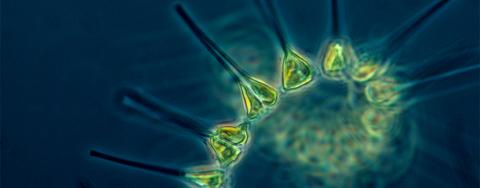
The Plankton Potential
Plankton don’t get the credit they deserve. Despite weighing at just 1% of the world’s photosynthetic biomass, these predominantly unicellular protists account for almost 50% of photosynthetic production, making them a very big deal that comes in a very small package. Researchers tackling genetics in microscopic marine life recently unlocked a new gene editing tool that could help us better understand plankton biology and leverage their promising potential to keep oceans clean.
Also called phytoplankton, from the Greek phylo (plant) and plankton (to drift or wander), these sort-of-fauna floaters play an incredibly important role in Earth’s ecosystem at large thanks to their unparalleled diversity. As noted by the NASA Earth Observatory, it’s hard to nail down a single plankton definition — some are bacteria, some are protists and many are single-celled plants. And that’s not all. Zooplankton are tiny animals that feed on phytoplankton and become food for fish and other species, while even smaller subsets — bacterioplankton and virioplankton — are also making oceanic rounds.
Mass-wise they’re not a big deal, but their sheer volume makes them valuable thanks to massive photosynthetic output; they’re one of the world’s most important producers of oxygen, according to National Geographic. They’re also critical in the carbon cycle: Plankton remove approximately 10 gigatonnes of carbon dioxide from the atmosphere each year and then transfer that carbon to sea life, lakes and deeper ocean layers.
Given their role as food for larger marine life, photosynthesis front-runners and carbon collectors, there’s no doubt that plankton play a critical role in environmental regulation — but their genetic makeup remains largely mysterious.
